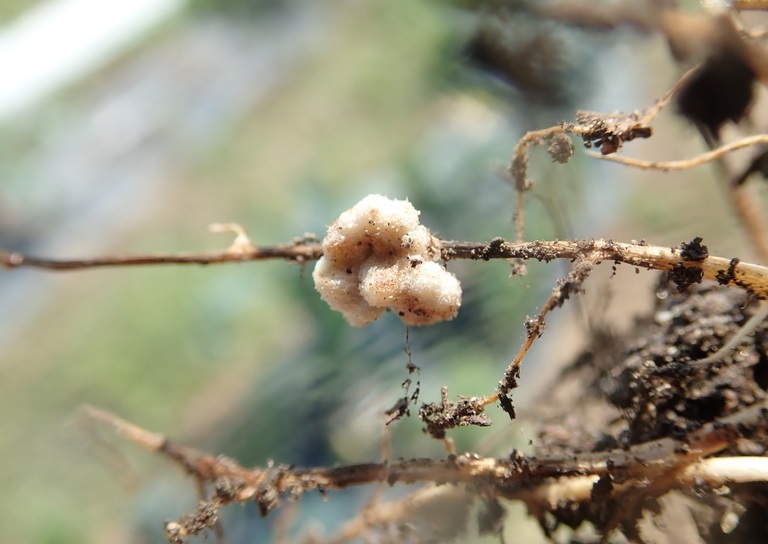Nitrogen fixation by legumes
Legume crops provide an important source of protein, carbohydrates and oils for humans and animals. One of their unique features is their ability to use atmospheric nitrogen as a nutrient source.
Nitrogen is an essential element in plant growth and development. It is a major component in plant amino acids, nucleic acids, chlorophyll, and other proteinic substances. Although nitrogen is the most abundant gas in the atmosphere, plants cannot use it in this form. In order for atmospheric nitrogen to be available to plants, it must first be reduced into ammonia, in a process called fixation. It is a biological process, carried out by specific species of bacteria. Nitrogen-fixing microorganisms are collectively known as diazotrophs and include rhizobia, azotobacter, azospirillum, Frankia alni and cyanobacteria.
 Nitrogen fixing nodules. Photo by: Whitney Cranshaw, Colorado State University, Bugwood.org
Nitrogen fixing nodules. Photo by: Whitney Cranshaw, Colorado State University, Bugwood.org
Due to their ability to fix atmospheric nitrogen, legume crops do not need any addition of nitrogen fertilizers.
Fertilization and irrigation ebook - Click for mor details
How do legumes fix nitrogen?
The nitrogen fixation process involves using energy (ATP) to break the strong triple covalent bonds that form dinitrogen molecules (N≡N, N2). Once the covalent bonds are broken, nitrogen is activated and can react with hydrogen to form ammonia (NH3), which is a nitrogen form that plants can use. The shown reduction equation represents biological nitrogen fixation: N2 + 8 H+ + 8 e– → 2 NH3 + H2.
This process is catalyzed by the nitrogenase enzyme, which nitrogen-fixing bacteria readily produce. As the fixation process consumes a lot of energy, non-photosynthetic nitrogen fixers such as rhizobium form associations with host plants to obtain energy-producing sugars.
Legumes form symbiotic relationships with non-photosynthetic bacteria known as rhizobia. In this relationship, legumes provide the bacteria with sugars, which are broken down to release energy required to reduce nitrogen. In return, rhizobia bacteria fix nitrogen that legumes utilize. In this symbiotic relationship, legumes form root nodules where the rhizobia bacteria transform atmospheric nitrogen into ammonia.
When the legumes uptake fixed nitrogen, they form green leaves (rich in chlorophyll). This improves the plant’s photosynthetic capability making the plant grow faster and healthier. When the plant matures and withers, the enriched leaves fall, returning the nitrogen into the soil.
Nodule formation
When rhizobia interact with leguminous plants roots, they trigger the formation of nodules that harbors the bacteria. In legumes such as soybeans, alfalfa, and clover, the process of nodulation starts when leguminous plant roots release flavanol compounds that entice the rhizobia bacteria. Then, rhizobia start to bind themselves at the root hairs. Binding occurs in two steps. First, the bacteria attach through calcium Ca2+ binding protein compound referred to as rhicadhesin.
Then after enough bacteria has been bound in the initial step, the bacteria bind through lectins or cellulose. The host plant will then notice “nod factors” released by the rhizobium bacteria, making the colonized root hairs entwine and form a shepherd’s crook. Then the bacteria will permeate the root hairs and create a tube-like structure known as infection thread. Once the symbiotic bacteria get to the main root, they cause cortical cell segmentation that results in a nodule formation.
Favorable conditions for biological nitrogen fixation
Nitrogenase enzymes consist of two soluble protein compounds, namely, components I and II. Component I (usually referred to as MoFe protein) consists of iron, molybdenum, and sulfides. Component II, also called nitrogenase reductase, consists of iron and sulfides.
Nitrogenase is oxygen-sensitive and is destroyed by high concentration of free oxygen. Leghemoglobin, an iron containing protein, produced by plants in the root nodules, binds to oxygen and maintains a low enough the level of free oxygen to protect nitrogenase. Research has shown that a neutral pH and temperature ranging from 26 – 37˚ C are suitable for maximum biological nitrogen fixation.




